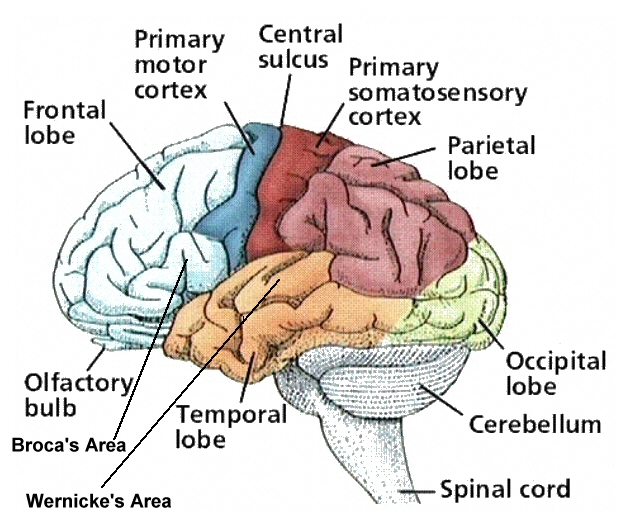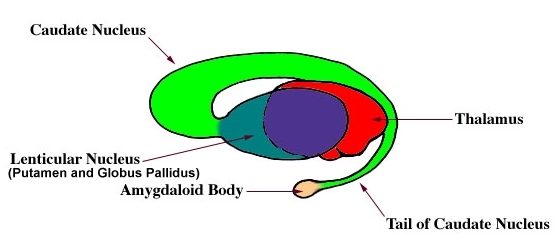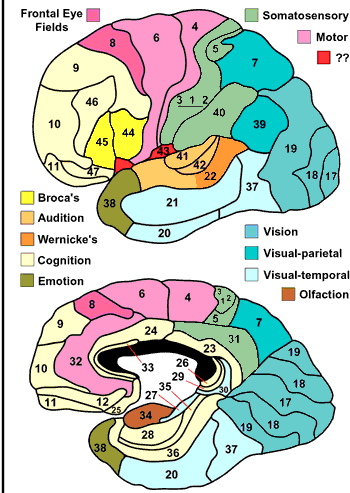Essential NeuroAnatomy
For Glossary of neuro anatomical terms click here
A.1 Introduction
The functional cellular unit of the Central
Nervous System is a nerve cell or Neuron. The neuron consists of a cell body
(soma), dendrites attached to the body, and an axon. Many axons are surrounded
by a myelin sheath, which has a white colour. Consequently those parts of the
brain that consist of mainly myelinated axons are called white matter. The
parts that contain aggregations of nerve cell bodies have a gray colour, hence
the term gray matter. Groups of nerve cell bodies in other parts of the brain
are called nuclei, or columns if they occur in long rows. Accumulations of
nerve cell bodies outside the CNS (central nervous system) are called ganglia.
Directions and Planes:
There are a number of special words that are
used to describe the position and direction of brain structures. These words
help describe the location of structures relative to other structures. For
example, we can say that the frontal lobe is “rostral” to the occipital lobe.
Table A.1 gives a listing of the anatomical terminology used to describe
directions.
Table A.1: Directional terms of the Body
|
Direction |
Description |
Direction |
Description |
Ventral |
Toward the belly (front) |
Dorsal |
Toward the back |
|
Rostral |
Toward the nose |
Caudal |
Toward the tail |
|
Superior |
Toward the top (of the
head/body) |
Inferior |
Toward the bottom |
|
Lateral |
Away from the middle |
Medial |
Toward the middle |
|
Ipsilateral |
On the same side |
Contralateral |
On the opposite side |
The brain, like all biological structures,
is three dimensional. So, any point on or inside the brain can be localized on
three "axes" or "planes" - the x, y and z axes or planes. The
brain is often cut (sectioned) into pieces for further study. These slices are
usually made in one of three planes: the coronal plane, the horizontal plane or
the sagittal plane as shown in Figure A.1.
The 'Talairach' coordinate system specifies
locations relative to their distance from the anterior commisure (AC). The AC
is a small but easy to spot region, making it an ideal origin for the coordinate
system. Each location is described by three numbers, each describing the
distance in millimeters from the AC: X is the left/right dimension, Y is the
posterior/anterior dimension, and Z is the ventral/dorsal dimension. Therefore,
the position 0x0x0 is precisely at the AC, while -32x21x10 is left (32mm),
anterior (21mm) and dorsal (10mm) from the AC. In this atlas the axial slices
are referred to by their Z coordinate and coronal images are referred to by
their Y coordinate. Again, it is important to stress that normalization strives
to retain the unique features of each individual brain, and therefore Talairach
coordinates are only approximate when comparing locations to other individuals.
Figure A.1: Planes of Section

The coronal plane, horizontal plane and
sagittal plane are shown in the figure A.1. The coronal plane is also called
the frontal plane. It cuts the brain into the anterior and posterior parts. The
horizontal (transverse or axial) plane cuts the brain into top (dorsal) and
bottom (ventral) parts. The sagittal plane divides the right and left side of
the brain into parts. The midsagittal plane would divide the right and left
sides of the brain into two equal parts.
A.2 Gross
Structure of the Brain
The human brain consists of two halves
(hemispheres) and resembles a peeled walnut. These two hemispheres communicate
with each other by a thick bundle of fibers called the corpus callosum.
Although the two hemispheres seem to be mirror images of each other, they are
different. The right hemisphere controls the left side of the body and
vice-versa. Each hemisphere is covered by a thick layer of gray substance, the
Cerebral Cortex. To increase the surface area, the cerebral cortex is heavily
folded. The folds are called convolutions, or gyri, and the grooves are
referred to as sulci, or fissures, if they are very deep. There are two main
sulci (or fissures) in the bran, visible on the lateral surface. These are
the lateral sulcus (also know as the Sylvian
fissure) and the central sulcus.
A.2.1 Cerebral
Structures
Each cerebral hemisphere can be divided into
four lobes (frontal, parietal, temporal, and occipital) each of which
specializes in different functions (Figure A.2).
Figure A.2: The four lobes of the brain

Frontal Lobe:
The frontal lobes lie directly behind the
forehead. The frontal lobe extends from the central sulcus to the anterior
limit of brain. The central sulcus separates the frontal lobe and the parietal
lobe. Inferiorly, the frontal lobe is separated from the temporal lobe by the
sylvian fissure which is also called the lateral fissure. It contains the motor
cortex and prefrontal cortex. The precentral gyrus, which may also be called
the primary motor area or, most commonly, the motor strip is immediately anterior
to the central sulcus. The amount of tissue on the precentral gyrus that is
dedicated to the innervation of a particular part of the body is proportional
to the amount of motor control needed by that area, not just its size. For
example, much more of the motor strip is dedicated to the control of the articulators
than to the legs. The premotor area or supplemental motor area is immediately
anterior to the motor strip. It is responsible for the programming for motor
movements. It does not, however program the motor commands for speech as these
are generated in Broca's area which is also located in the frontal lobe.
Broca's Area is found on the inferior frontal gyrus in the hemisphere that is
dominant for language. The most anterior part of the frontal lobe is (called
the prefrontal cortex) and is involved in complex cognitive processes like
reasoning and judgment.
Parietal Lobe:
The Parietal Lobe is immediately posterior
to the central sulcus. It is anterior to the occipital lobe, from which it is not
separated by any natural boundary. Its inferior boundary is the posterior
portion of the lateral fissure which divides it from the temporal lobe. The
Parietal region processes body information including touch, information from
muscle stretch receptors and joint receptors. The postcentral gyrus which is
also called the primary sensory area or the sensory strip is immediately
posterior to the central sulcus. This area receives sensory feedback from joints
and tendons in the body and is organized in the same manner as the motor strip.
The sensory association areas are located behind the postcentral gyrus. These
areas are capable of more detailed discrimination and analysis than is the
primary sensory area. They might, for example, be involved in sensing how hot
or cold something is rather than simply identifying it as hot or cold.
Information is first processed in the primary sensory area and is then sent to
the secondary sensory areas.
Temporal Lobe:
The temporal lobe is located laterally in
each hemisphere, near the temples. The Temporal Lobe is inferior to the lateral
fissure and anterior to the occipital lobe. It is separated from the occipital
lobe by an imaginary line rather than by any natural boundary. The temporal
lobe is associated with auditory processing, olfaction, and some complex
aspects of vision (i.e., perception of complex patterns and faces). It is also
involved in semantics, or word meaning. Wernicke's Area is located on the posterior
portion of the superior temporal gyrus. In the hemisphere that is dominant for
language, this area plays a critical role in the ability to understand and
produce meaningful speech. The anterior transverse temporal gyrus, is the
primary auditory area. There are two secondary auditory or auditory association
areas which make important contributions to the comprehension of speech. They
are not completely responsible for this ability, however, as many areas, including
Wernicke's area, are involved in this
process. The angular gyrus lies near the superior edge of the temporal lobe,
immediately posterior to the supramarginal gyrus. It is involved in the
recognition of visual symbols. Fibers of many different types travel through
the angular gyrus, including axons associated with hearing, vision, and meaning.
Occipital Lobe:
The occipital lobe is located in the
posterior, caudal end of the cortex. It is the main target for axons from
thalamic nuclei that receive inputs from the visual pathways. It contains the
primary visual cortex. The secondary visual areas integrate visual information,
giving meaning to what is seen by relating the current stimulus to past
experiences and knowledge. A lot of memory is stored here. These areas are
superior to the primary visual cortex. It is important to remember that while
some functions can be localized to very specific parts of the brain, others
cannot be classified in this way because many areas are involved in their
performance. Word-finding, for example, is associated with several different
areas. Also, we cannot say that all higher level cognitive functioning is
associated with the frontal lobe; the processing of word meaning carried out by
Wernicke's certainly involves a sophisticated type of cognition. Also, right
hemisphere lesions often result in cognitive/perceptual problems.
A.2.2 Subcortical
Structures
The Basal Ganglia are groups of neurons
positioned subcortically. They include the caudate nucleus, putamen, and globus
pallidus. The caudate nucleus and the putamen together form the corpus striatum
or simply striatum. The globus pallidus contains more myelinated fibers than
the adjacent striatum (putamen) and is accordingly, lighter in colour. The
globus pallidus and the putamen together form a lens-shaped mass called the
lenticular or lentiform nucleus. The caudate nucleus is an elongated C-shaped nuclear
mass, which wraps around the upper and lateral border of the lateral ventricle.
The putamen lies laterally to the globus pallidus. The amygdala, which is
involved in emotion, was once classified as part of the basal ganglia, but is
no longer categorized in this way. It is still considered to be a part of the
limbic system. It is attached to the tail of the caudate nucleus. The
subthalamic nuclei and the substantia nigra are both functionally related to
the basal ganglia, but are not considered to be part of that structure. The
corpus callosum, which is Latin for "large body" is the major group
of commissural fibers. It is located some distance down inside the longitudinal
cerebral fissure, the split that separates the hemispheres. The other two groups
of commissural fibers are called the anterior commissure and the posterior
commissure. Both are connected to the corpus callosum. The limbic system
consists of both cortical and
Subcortical structures which are located on
the medial, inferior surfaces of the cerebral hemispheres. The cortical areas classified
as part of the limbic system include the hippocampus, the cingulate gyrus, and
the subcallosal gyrus. The hippocampus, is a gyrus found on the medial edge of
the temporal lobe. It is named for its shape, as hippocampus literally means
"sea horse". The cingulate gyrus is immediately superior to the
corpus callosum. The subcallosal gyrus is immediately inferior to the corpus
callosum. The thalamus has been described as the switchboard for the cortex. It
receives information from the cerebellum, the basal ganglia and from all
sensory pathways with the exception of the
Figure A.3: Basal Ganglia

olfactory tract; it integrates the messages
and sends them on to the cortex for further processing. Both the thalamus and hypothalamus
are located in the center of the brain at the level of the temporal lobe. They
are very well protected in this area. The thalamus is located below the caudate
nucleus and the fornix and is medial to the lenticular nucleus. It is composed
of two bodies which are separated from one another by the third ventricle, with
one lying in each hemisphere. The two thalamic bodies are connected to one
another by another part of the thalamus, the massa intermedia or thalamic
adhesion, which makes up part of the ventricle. The subthalamus is located
ventral to the thalamus and is important for motor movement. It has connections
to the basal ganglia, thalamus and brainstem. The hypothalamus is a solid
structure that is located immediately inferior to the thalamus. Part of it is
also anterior to the thalamus. It forms the floor and part of the lateral walls
of the third ventricle.
A.2.3 Cerebellum
Cerebellum is situated at the bottom of the
brain. It consists of two cerebellar hemispheres joined in the midline by a
narrow worm like portion called the vermis. Like the cerebral hemispheres, the cerebellum
is covered with a layer of gray substance and is called the Cerebellar Cortex.
A.3 Brodmann's
Classification System
Studies done by Brodmann in the early part
of the twentieth century generated a map (Figure A.4) of the cortex covering
the lobes of each hemisphere. These studies involved electrical probing of the
cortices of epileptic patients during surgery. Brodmann numbered the areas that
he studies in each lobe and recorded the psychological and behavioural events
that accompanied their stimulation.
Figure A.4: Brodmann's labels

The Frontal Lobe contains areas that Brodmann
identified as involved in cognitive functioning and in speech and language.
¨
Area 4
corresponds to the precentral gyrus or primary motor area.
¨
Area 6 is the
premotor or supplemental motor area.
¨
Area 8 is
anterior of the premotor cortex. It facilitates eye movements and is involved
in visual reflexes as well as pupil dilation and constriction.
¨
Areas 9, 10,
and 11 are anterior to area 8. They are involved in cognitive processes like
reasoning and judgement which may be collectively called biological
intelligence.
¨
Area 44 is
Broca's area.
Areas in the Parietal Lobe play a role in somatosensory
processes.
¨
Areas 3, 2,
and 1 are located on the primary sensory strip, with area 3 being superior to
the other two. These are somastosthetic areas, meaning that they are the
primary sensory areas for touch and kinesthesia.
¨
Areas 5, 7,
and 40 are found posterior to the primary sensory strip and correspond to the
presensory to sensory association areas.
¨
Area 39 is the
angular gyrus.
Areas involved in the processing
of auditory information and semantics as well as the appreciation of smell are
found in the Temporal
Lobe.
¨
Area 41 is the
primary auditory area.
¨
Area 42
immediately inferior to area 41 and is also involved in the detection and
recognition of speech. The processing done in this area of the cortex provides
a more detailed analysis than that done in area 41.
¨
Areas 21 and
22 are the auditory association areas. Both areas are divided into two parts;
one half of each area lies on either side of area 42.
¨
Area 37 is
found on the posterior-inferior part of the temporal lobe.
The Occipital Lobe contains areas that process
visual stimuli.
¨
Area 17 is the
primary visual area.
¨
Areas 18 and
19 are the secondary visual areas.
A.4 Sources and
Further Reading
The material and figures in this page have
been compiled from the following resources and several other material on the
world wide web
¨
The
Neuroscience on the Web Series:
SPPA 362, Neuroanatomy of Speech, Swallowing and Language by Patrick McCaffrey,
Colarado State University, Chico.
o Unit 4. Cerebral Lobes, Cerebral Cortex, and
Brodmann's Areas http://www.csuchico.edu/pmccaff/syllabi/SPPA362/362unit4.html
o Unit 5. The Corpus Striatum, Rhinencephalon,
Connecting Fibers, and Diencephalon http://www.csuchico.edu/pmccaff/syllabi/SPPA362/362unit5.html
¨
Brain and
Behaviour, Psychology 112
by Kalina Christoff Stanford University, Department of Psychology.
o Lecture 2. BRAIN STRUCTURE AND FUNCTION I. http://www-psych.stanford.edu/~kalina/BB/Lecture02/index.html
¨
Neuroscience
for Kids by Eric Chudler,
Research Associate Professor, Department of Anesthesiology, University of
Washington, Seattle. http://faculty.washington.edu/chudler/neurok.html
o Directions and Planes of Section http://faculty.washington.edu/chudler/slice.html
¨
Brain
Facts: A Primer On The Brain And Nervous System by The Society for NeuroScience, USA. ISBN
0-916110-00-1 http://web.sfn.org/content/Publications/BrainFacts/brainfacts.pdf
¨
Glossary of
Terms http://serendip.brynmawr.edu/bb/kinser/Glossary.html
¨
Neuroscience:
A Journey Through the Brain
http://www.ualberta.ca/neuro/OnlineIntro/Index.htm
¨
Brain
Basics: Know Your Brain Prepared
by National Institute of Neurological Disorders and Stroke, National Institutes
of Health, USA. http://www.ninds.nih.gov/health and
medical/pubs/ brain basics know your brain.htm
¨
Reza
Shadmehr's course notes at Laboratory for Computational Motor Control,
Johns Hopkins University. http://www.bme.jhu.edu/~reza/courses
page.html